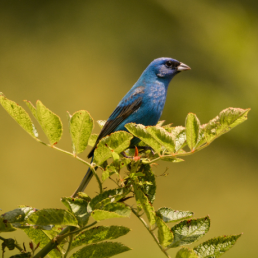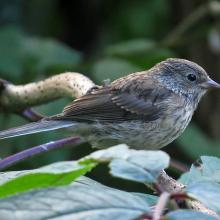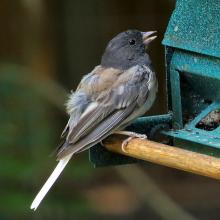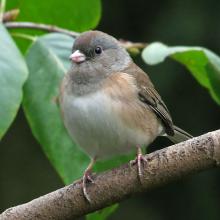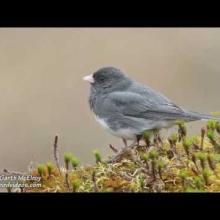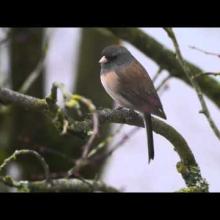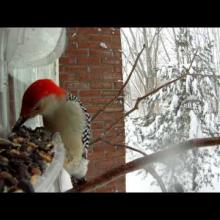

Join BirdNote tomorrow, November 30th!
Illustrator David Sibley and actor H. Jon Benjamin will face off in the bird illustration battle of the century during BirdNote's Year-end Celebration and Auction!
You may see Dark-eyed Juncos in the summer, but come fall, many more — those that have been nesting in the mountains or farther north — arrive to spend the winter. These juncos often visit birdfeeders for winter feasting. Dark-eyed Juncos forage on the ground. The flash of white tail-feathers when one is alarmed alerts other members of the flock, and is also used as part of the courtship display.
BirdNote®
The Return of the Snowbird
Written by Frances Wood
This is BirdNote!
[Twittering call and winter chipping of Dark-eyed Junco]
By now, retirees and other people who want to escape the dark days of winter have headed to California or parts of the Southwest, or to sunny Florida. We call them “snowbirds,” because they leave as soon as the snow begins to fall and temperatures drop.
But there’s another type of snowbird — the Dark-eyed Junco. [More chipping]
Although you may see Dark-eyed Juncos here in summer, come fall, many, many more arrive to spend the winter. They’ve been nesting in the mountains or farther north. To them, this is a benign winter habitat.
These juncos often find seed feeders for winter feasting. Watch for a small bird with a dark sooty hood that covers its head and chest, a grey-brown back, and a white belly. However, the most attention-grabbing aspect of this shy junco is its tail. As the bird darts off, giving a sharp twittering call, it flashes the white outer feathers of its tail. [Twittering call]
Enjoy these Dark-eyed Juncos now and through the winter. Come spring, most of these snowbirds will head north or into higher elevations to begin a new breeding cycle. [More chipping calls]
For BirdNote, I’m Mary McCann. If you know someone who might enjoy today's program, send them to our website, BirdNote.org.
###
Twittering call and spring song of the Dark-eyed Junco provided by Martyn Stewart, naturesound.org.
Chipping call of the Dark-eyed Junco provided by The Macaulay Library of Natural Sounds at the Cornell Lab of Ornithology, Ithaca, New York. Recorded by W.L. Hershberger
Producer: John Kessler
Executive Producer: Chris Peterson
© 2015 Tune In to Nature.org November 2014/2018/2019/2022 Narrator: Mary McCann
ID#111705DEJUKPLU DEJU-03b
